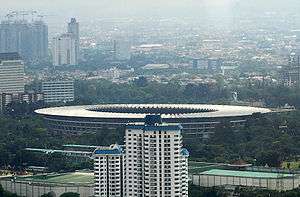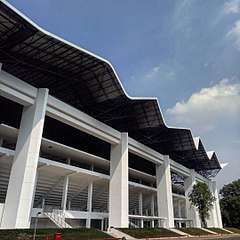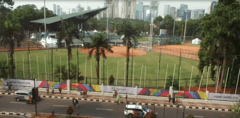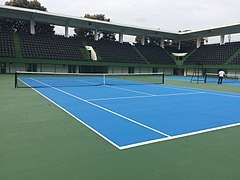Gelora Bung Karno Sports Complex
Coordinates: 6°13′6.88″S 106°48′9.04″E / 6.2185778°S 106.8025111°E
.jpg)

Bung Karno Sports Arena (Indonesian: Gelanggang Olahraga Gelora Bung Karno, known as Gelora Bung Karno Sports Complex), formerly named Senayan Sports Arena (Indonesian: Gelanggang Olahraga Senayan) from 1969 to 2001, is a sports complex located between Gelora, Central Jakarta and Senayan, South Jakarta, Indonesia. The sports complex hosts main stadium, secondary stadium, football fields, aquatics stadium, tennis stadiums (indoor and outdoor), hockey, baseball and archery fields, and several indoor gymnasiums. The complex was built in 1960 for the 1962 Asian Games and recently underwent a major reconstruction for the 2018 Asian Games and 2018 Asian Para Games.
The sports complex host a main stadium with a capacity of 77,193 seats, athletic stadium, football fields, aquatics stadium, tennis stadiums (indoor and outdoor), hockey, baseball and archery fields, and several indoor gymnasiums. It is named after Sukarno, Indonesia's first President.[1] It is the largest and one of the oldest sport complex in Jakarta and Indonesia, and also one of the largest in Southeast Asia. The Gelora Bung Karno Stadium is the main building within this sports complex. The abbreviation Gelora also means "vigorous" (like the flame or ocean wave) in Indonesian language.
Other than hosting numbers of sports facilities, the sports complex is also a popular place for people of Jakarta to do physical exercises; jogging, bicycling, aerobics and calisthenics especially during weekend.
History
After the Asian Games Federation declared Jakarta to host the 1962 Asian Games in 1958, the minimum requirement that yet to be met by the Jakarta was the availability of a multi-sport complex. In response to this, President Sukarno issued Presidential Decree No. 113/1959 dated 11 May 1959 about the establishment of the Asian Games Council of Indonesia (DAGI) led by Minister of Sports Maladi. Sukarno, as an architect and civil engineering graduate, proposed a location near M. H. Thamrin Boulevard and Menteng, namely the area of Karet, Pejompongan, or Dukuh Atas. Frederich Silaban, a renowned architect who accompanied Sukarno to review the location by helicopter, disagreed with the selection of Dukuh Atas because he argued the construction of a sports complex in the center the future downtown area will potentially create a massive traffic congestion. Sukarno agreed and instead assigned the Senayan area with an area of approximately 300 hectares.[2]
The first pole erection was done symbolically by Sukarno on 8 February 1960. Construction of Istora was completed on May 1961. The secondary stadium, Swimming stadium and Tennis stadium followed in December 1961. The main stadium was completed on 21 July 1962, a month before the games.[3]
Facilities
.jpg)




Sports venues
| Venue | Purpose | Capacity | Year Built | Notes |
|---|---|---|---|---|
| Gelora Bung Karno Main Stadium | Multi-use, mostly football | 77,193 | 1960 | Largest stadium in Indonesia. |
| Istora Gelora Bung Karno | Multi-use, mostly badminton | 7,166 | 1960 | |
| Gelora Bung Karno Aquatic Center | Aquatics | 7,800 | 1960 | |
| Tennis Indoor | Multi-use, mostly concerts | 3,750 | 1993 | |
| Tennis Outdoor | Tennis | 3,800 | 1960 | |
| Gelora Bung Karno Madya Stadium | Athletics | 9,170 | 1960 | |
| Basketball Hall | Basketball | 2,400 | 1960 | |
| Baseball Stadium | Baseball | 2,000 | 2016 | Built on site formerly a part of the Tennis Outdoor |
| Hockey Field | Field hockey | 818 | 1973 | |
| Hasjrul Harahap Softball Field | Softball | 2,000 | 1996 | Also called Lapangan Softball Pintu Satu (Pintu Satu Softball Field) to distinguish it with the nearby, now-demolished Cemaratiga Softball Field. |
| Archery Field | Archery | 293 | 2016 | |
| Rugby Field | Rugby | - | 2016 | Built on the former PASI Jaya Athletic Stadium (completed in 1973) |
| Shooting Range | Shooting | - | 1992 | New location. Mulia Hotel now stands in the original location |
| Gelora Bung Karno Arena | Multi-sports training halls | - | 2016 | Built on the former Asia Afrika Sport Hall, a badminton training hall (completed in 1986) |
| Volleyball Training Hall | Volleyball training | - | 1988 | |
| A, B, and C Football Training Field | Football training | - | - | |
| Senayan National Golf Course | Golf | - | 1968 | |
| Krida Loka Jogging Track | Jogging | - | 1987 |
Other buildings
Other buildings inside the complex
- Jakarta Convention Center (completed 1974)
- Al Bina mosque (completed 2001)
- Jakarta Sultan Hotel (formerly Hilton Hotel Jakarta, completed 1971)
- Mulia Hotel (completed 1994)
- Radio-controlled car circuit
- Central office of National Sports Committee of Indonesia
Initially the sports complex covers much larger area than it is today. During the 1980s to 1990s, several land plots were developed into non-sport facilities. Northern area were developed into government offices while the southern area were developed into hotels and shopping malls.
Northern area
- DPR/MPR Building (completed 1968)
- TVRI Headquarters (completed 1962)
- Ministry of Youth and Sports building (completed 1983)
- Ministry of Forestry building (Manggala Wanabakti, completed 1983)
Southern area
The southern area was originally an athlete village for the 1962 Asian Games. The village was demolished in the 1970s. Several buildings now stood in their location.
- Athlete Century Park Hotel (completed 1990)
- Ratu Plaza (completed 1982)
- Plaza Senayan (completed 1996)
- Senayan Trade Center (completed 2006)
- Senayan City (completed 2006)
- fX Sudirman (completed 2008)
- Fairmont Jakarta Hotel (completed 2015)
Sport events
For the first time, the sports complex was host fourth Asian Games in 1962. The Main Stadium hosted the 2007 AFC Asian Cup. Other competitions held there were several AFF Championship finals and domestic cup finals. The Istora Senayan hosted numbers of Sudirman Cup, Thomas Cup and Uber Cup badminton competitions. The sports complex hosted multi-event sport such as Pekan Olahraga Nasional (PON, National Sports Week) and Southeast Asian Games (SEA Games). The complex hosted the PON nine times between 1951 and 1996. The complex hosted the SEA Games in 1979, 1987, 1997 and 2011; the latter was co-hosted with Jakabaring Sport City complex in Palembang. It also hosted 2018 Asian Games along with Palembang's complex, while it serves alone during the subsequent Para Games.
Footnotes
- ↑ Schwarzer gives kind assessment of Kawaguchi | The Japan Times Online
- ↑ "Sukarno dan GBK". historia.id (in Indonesian). Retrieved 2018-01-21.
- ↑ Pour, Julius (2004). Dari Gelora Bung Karno ke Gelora Bung Karno. Grasindo.
Bibliography
- Pour, Julius (2004), Dari Gelora Bung Karno ke Gelora Bung Karno (in Indonesian), Jakarta: Grasindo, ISBN 978-979-732-444-5.
External links
| Wikimedia Commons has media related to Gelora Bung Karno Stadium. |
- Gelora Bung Karno - Official Website